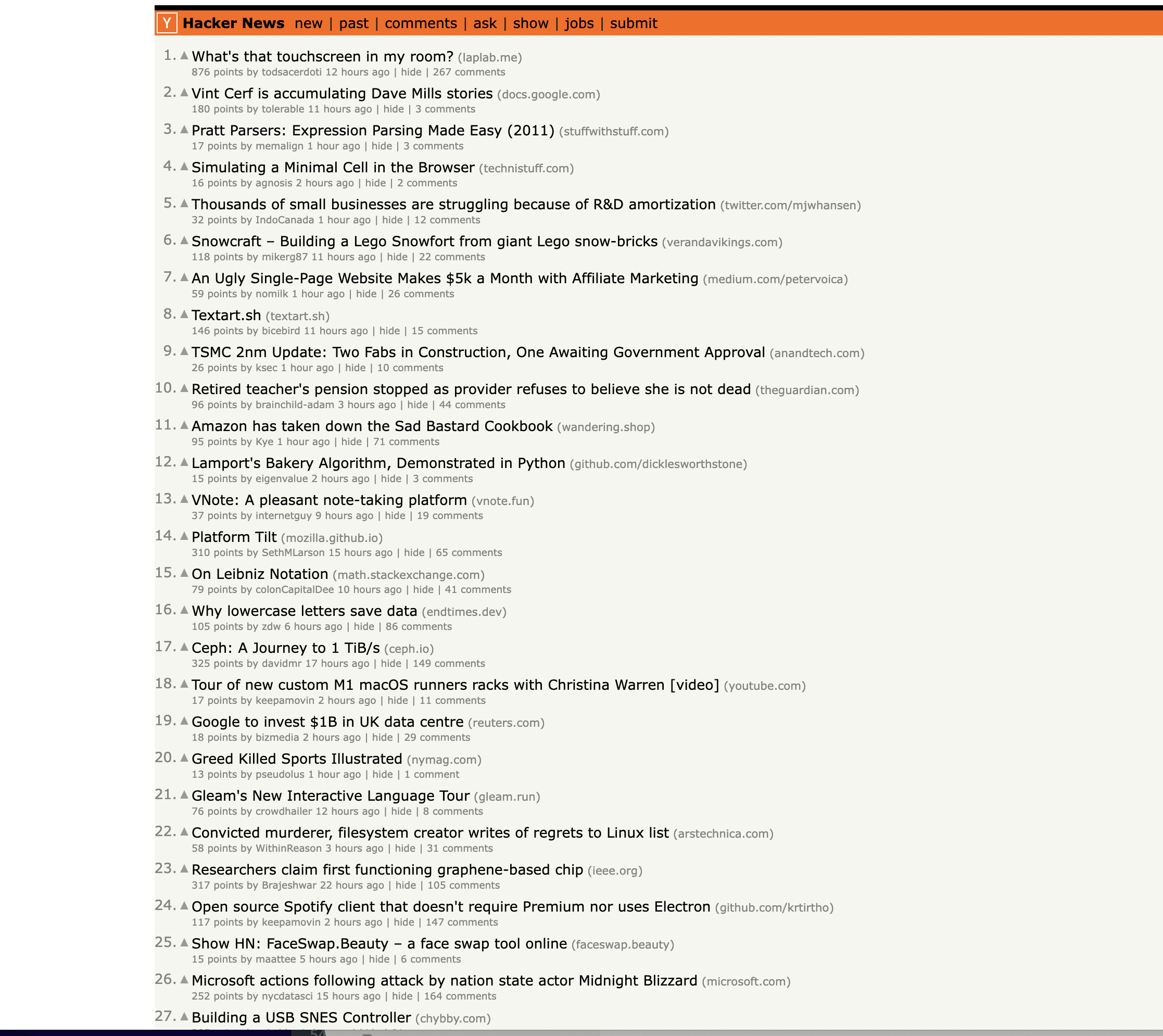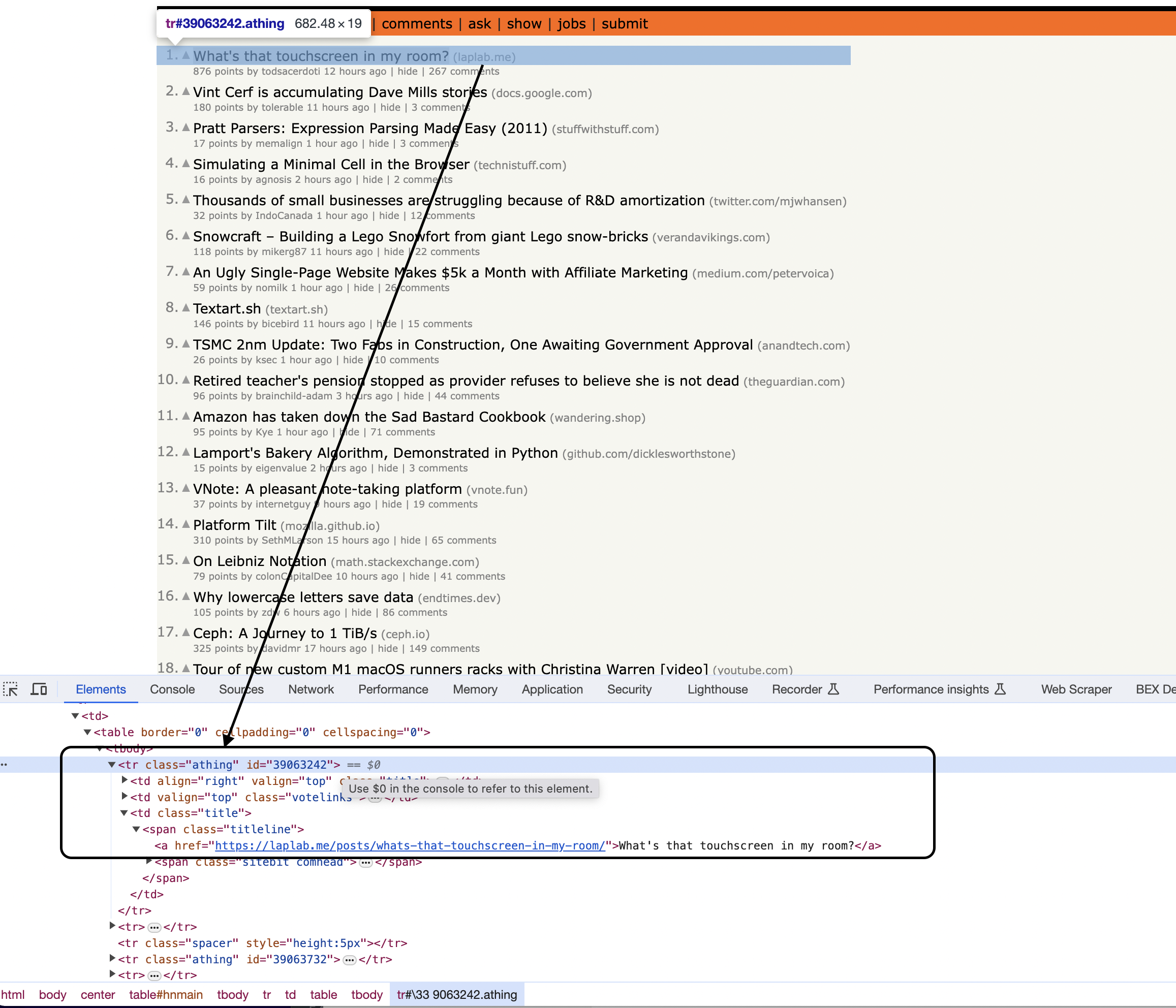Web scraping is a technique for extracting information from websites. In this beginner Scala tutorial, we'll walk through code that scrapes article data from the Hacker News homepage using the Jsoup Java library.
This is the page we are talking about…

Installation
First, ensure Jsoup is installed by adding the following Maven dependency to your project:
<dependency>
<groupId>org.jsoup</groupId>
<artifactId>jsoup</artifactId>
<version>1.13.1</version>
</dependency>
Overview
Here is the full code we'll be going through:
import org.jsoup.Jsoup
object HackerNewsScraper {
def main(args: Array[String]): Unit = {
// Define the URL of the Hacker News homepage
val url = "<https://news.ycombinator.com/>"
// Send a GET request to the URL and parse the HTML content
val doc = Jsoup.connect(url).get()
// Find all rows in the table
val rows = doc.select("tr")
// Initialize variables to keep track of the current article and row type
var currentArticle: org.jsoup.nodes.Element = null
var currentRowType: String = null
// Iterate through the rows to scrape articles
for (row <- rows) {
if (row.hasClass("athing")) {
// This is an article row
currentArticle = row
currentRowType = "article"
} else if (currentRowType == "article") {
// This is the details row
if (currentArticle != null) {
// Extract information from the current article and details row
val titleElem = currentArticle.select("span.titleline")
if (titleElem != null && titleElem.size() > 0) {
val articleTitle = titleElem.select("a").text() // Get the text of the anchor element
val articleUrl = titleElem.select("a").attr("href") // Get the href attribute of the anchor element
val subtext = row.select("td.subtext")
val points = subtext.select("span.score").text()
val author = subtext.select("a.hnuser").text()
val timestamp = subtext.select("span.age").attr("title")
val commentsElem = subtext.select("a:contains(comments)")
val comments = if (commentsElem != null && commentsElem.size() > 0) commentsElem.text() else "0"
// Print the extracted information
println("Title: " + articleTitle)
println("URL: " + articleUrl)
println("Points: " + points)
println("Author: " + author)
println("Timestamp: " + timestamp)
println("Comments: " + comments)
println("-" * 50) // Separating articles
}
}
// Reset the current article and row type
currentArticle = null
currentRowType = null
} else if (row.attr("style") == "height:5px") {
// This is the spacer row, skip it
// do nothing
}
}
}
}
In the rest of this article, we'll break down what each section is doing.
Importing Jsoup
We first import Jsoup, which is the Java library that allows us to make HTTP requests and parse HTML:
import org.jsoup.Jsoup
Defining the Entry Point
Next we define a Scala object with a
object HackerNewsScraper {
def main(args: Array[String]): Unit = {
// scraping code goes here
}
}
Getting the Hacker News Page HTML
Inside the main method, we start by defining the URL of the Hacker News homepage:
val url = "<https://news.ycombinator.com/>"
We then use Jsoup to send a GET request to this URL and parse/load the returned HTML content:
val doc = Jsoup.connect(url).get()
The
Selecting Rows
Inspecting the page
You can notice that the items are housed inside a With the HTML document loaded, we next find all This gives us a list of elements containing each We initialize two variables to keep track of state as we parse each row: We loop through each row to identify article content: Inside this loop is the main parsing logic... We first check if a row has the "athing" class to determine if it is an article: If so, we save the row to Next, we check if the previous row type was an "article", indicating this is a details row: Inside the details row, we can now extract information from the article and details row since we have both available in Let's focus on how the title field is extracted... First, we select the Notice here we are using a CSS selector again, targeting the element by class name. If This drills into The URL extraction works similarly, getting the The same process is followed to extract points, author, comments etc. each into their own variables by selecting different elements from either the article or details row. Finally, we print the information: The other fields like points, author, and comments are extracted in the same way using Jsoup selectors targeting elements by class or tag name. After extracting article details, we reset We also include logic to detect and skip spacer rows: This checks for a particular And that covers the full logic to scrape article information from Hacker News using Jsoup selectors! Here is the complete runnable code again for reference: This is great as a learning exercise but it is easy to see that even the proxy server itself is prone to get blocked as it uses a single IP. In this scenario where you may want a proxy that handles thousands of fetches every day using a professional rotating proxy service to rotate IPs is almost a must. Otherwise, you tend to get IP blocked a lot by automatic location, usage, and bot detection algorithms. Our rotating proxy server Proxies API provides a simple API that can solve all IP Blocking problems instantly. Hundreds of our customers have successfully solved the headache of IP blocks with a simple API. The whole thing can be accessed by a simple API like below in any programming language. In fact, you don't even have to take the pain of loading Puppeteer as we render Javascript behind the scenes and you can just get the data and parse it any language like Node, Puppeteer or PHP or using any framework like Scrapy or Nutch. In all these cases you can just call the URL with render support like so: We have a running offer of 1000 API calls completely free. Register and get your free API Key.
Get HTML from any page with a simple API call. We handle proxy rotation, browser identities, automatic retries, CAPTCHAs, JavaScript rendering, etc automatically for you
curl "http://api.proxiesapi.com/?key=API_KEY&url=https://example.com" <!doctype html> Enter your email below to claim your free API key: tag with the class athing 
table rows on the page using a CSS selector: val rows = doc.select("tr")
to iterate through later. Tracking State
var currentArticle: org.jsoup.nodes.Element = null
var currentRowType: String = null
Iterating Rows
for (row <- rows) {
// parsing logic
}
Identifying Article Rows
if (row.hasClass("athing")) {
currentArticle = row
currentRowType = "article"
}
Identifying Details Rows
} else if (currentRowType == "article") {
// extract details for current article
}
Extracting Article Data
// Extract information from current article and details row
val titleElem = currentArticle.select("span.titleline")
if (titleElem != null && titleElem.size() > 0) {
val articleTitle = titleElem.select("a").text()
val articleUrl = titleElem.select("a").attr("href")
// extract other fields like points, author etc.
println(articleTitle)
println(articleUrl)
}
val titleElem = currentArticle.select("span.titleline")
val articleTitle = titleElem.select("a").text()
println("Title: " + articleTitle)
println("URL: " + articleUrl)
// etc.
Resetting State
currentArticle = null
currentRowType = null
Skipping Spacer Rows
} else if (row.attr("style") == "height:5px") {
// skip spacer row
}
Full Code
import org.jsoup.Jsoup
object HackerNewsScraper {
def main(args: Array[String]): Unit = {
// Define the URL of the Hacker News homepage
val url = "https://news.ycombinator.com/"
// Send a GET request to the URL and parse the HTML content
val doc = Jsoup.connect(url).get()
// Find all rows in the table
val rows = doc.select("tr")
// Initialize variables to keep track of the current article and row type
var currentArticle: org.jsoup.nodes.Element = null
var currentRowType: String = null
// Iterate through the rows to scrape articles
for (row <- rows) {
if (row.hasClass("athing")) {
// This is an article row
currentArticle = row
currentRowType = "article"
} else if (currentRowType == "article") {
// This is the details row
if (currentArticle != null) {
// Extract information from the current article and details row
val titleElem = currentArticle.select("span.titleline")
if (titleElem != null && titleElem.size() > 0) {
val articleTitle = titleElem.select("a").text() // Get the text of the anchor element
val articleUrl = titleElem.select("a").attr("href") // Get the href attribute of the anchor element
val subtext = row.select("td.subtext")
val points = subtext.select("span.score").text()
val author = subtext.select("a.hnuser").text()
val timestamp = subtext.select("span.age").attr("title")
val commentsElem = subtext.select("a:contains(comments)")
val comments = if (commentsElem != null && commentsElem.size() > 0) commentsElem.text() else "0"
// Print the extracted information
println("Title: " + articleTitle)
println("URL: " + articleUrl)
println("Points: " + points)
println("Author: " + author)
println("Timestamp: " + timestamp)
println("Comments: " + comments)
println("-" * 50) // Separating articles
}
}
// Reset the current article and row type
currentArticle = null
currentRowType = null
} else if (row.attr("style") == "height:5px") {
// This is the spacer row, skip it
// do nothing
}
}
}
}curl "<http://api.proxiesapi.com/?key=API_KEY&render=true&url=https://example.com>"
Browse by language:
The easiest way to do Web Scraping
Try ProxiesAPI for free
<html>
<head>
<title>Example Domain</title>
<meta charset="utf-8" />
<meta http-equiv="Content-type" content="text/html; charset=utf-8" />
<meta name="viewport" content="width=device-width, initial-scale=1" />
...Don't leave just yet!